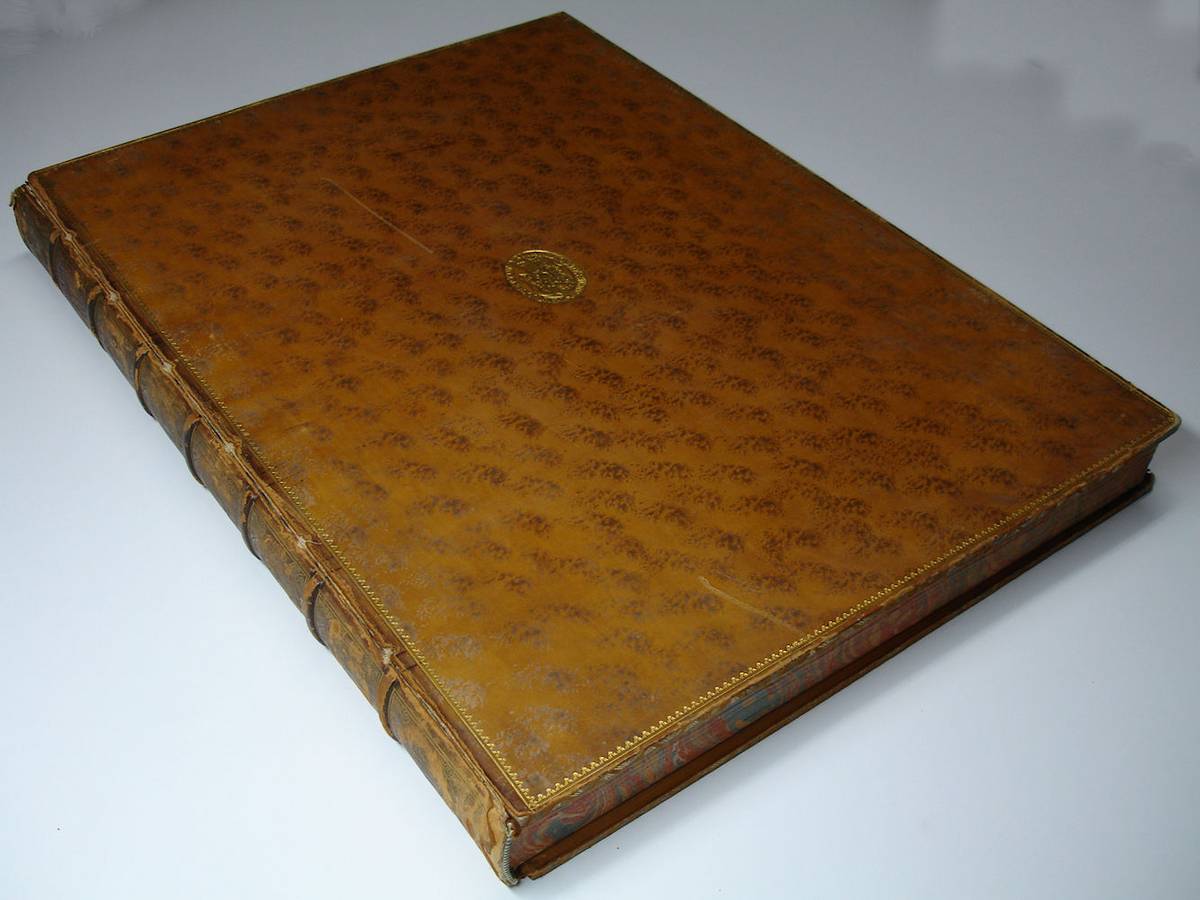HOMERUS.
Iliadis fragmenta antiquissima cum picturis, item scholia vetera ad Odysseam, edente Angelo Maio Ambrosiani Collegii doctore Regiarum Galliae, Belgii, Bavariae et Neapolis Academiarum sodale.
Milan, (Mediolani), Regiis Typis, 1819.
Large folio. (VIII),LVI pages; leaves (II), I-LVIII, pages LIX-LXX; 1-164 pages. Calf. 60 x 35 cm (
Ref: . Hoffmann 2,328; Schweiger 1,161; Brunet 3,282; Ebert 10007; Graesse 3,331; Sandys 3,241) (
Details: Back gilt, and with 7 raised bands. Boards with gilt borders and a gilt coat of arms in the centre. Marbled endpapers. Nice engraved architectural title, with 9 round medaillons, 3 of which are portraits of Achilles, Homer and Odysseus, the others show scenes from the Ilias and Odyssea. One full page specimen of the Greek script; 58 engravings accompanying 58 fragments from a 'Codex Ambrosianus Pictus'. Three sumptuous engraved headpieces, one text illustration. Fresh white paper, with very broad margins) (
Condition: Upper board detached. Back chafed & damaged. Joint of the lower board cracking, but still strong. Boards with some scratches and rubbings. 2 small wormholes in margin of last 4 leaves. Some faint foxing) (
Note: This Homer edition of 1819 consists of four parts, 1: A dedication, and Angelo Mai's informative introduction, 'De codicibus Ambrosianis editoris Prooemium' (page I-LVI); 2: 'Iliadis Fragmenta et Picturae' (ca. 800 verses with 58 engravings after 6th century illustrations of scenes in the Ilias), to which are subjoined 6 pages critical notes of the 'variae lectiones' found in this manuscript (page LIX-LXIV); 3: 'Scholia Veterum Grammaticorum ad Homeri Odysseae ex Ambrosianis codicibus (13th century) eruta' (page LXV-LXX & 1-148); 4: 'Didymi Alexandrini Marmorum et Lignorum quorumvis Mensurae' (p. 149/164). § In 1609 the Milanese 'Bibliotheca Ambrosiana' acquired the library of the Italian humanist Gian Vincenzo Pinelli. One of the 800 acquired 'codices' was a 13th century paper manuscript, containing scholia on the Ilias. On the pages of that manuscript had been glued for illustration 51 parchment fragments with 58 scenes from the Ilias. After the removal of these pieces of parchment, Mai discovered on the reverse of the pictures the original writing, about 800 verses of the Ilias, in a majuscule that is based on the ancient Roman uncials. These fragments, known as the 'Codex Ambrosianus Pictus', or 'Ilias Picta', or in English the 'Ambrosian Iliad', (Biblioteca Ambrosiana, Cod. F. 205 Inf.), were once part of a large-scale illustrated manuscript of Homer's Iliad, which was made ca. 500 in Constantinople or Alexandria. Together they are the oldest surviving manuscript illustrations of the Ilias. Angelo Mai was the first to present them to the learned world in this edition of 1819. § Mai collected from different manuscript in the Ambrosian Library also scholia upon the Odyssea, made by several ancient grammarians. At the end Mai added also 4 fragments of a text of the first century B.C. grammarian Didymus Alexandrinus, 'De lignorum mensuris et marmoribus vel 'Peri tôn marmarôn kai pantoiôn xulôn metrêseôs'' (On the measurement of marble and all kinds of wood); their source is the Greek mathematician Heron of Alexandria, and the text is now known as Didymus' Fragment 68. (B.K. Braswell, 'Didymos of Alexandria: Commentary on Pindar (..) and a critical catalogue of Didymos' Works', Basel 2017, p. 101)) § The discovery of the Homeric scenes of the 'Codex Ambrosianus Pictus', and their printed reproduction in 1819 is a landmark of Homeric study. The Italian scholar Angelo Mai, 1782-1854, was librarian of the 'Bibliotheca Ambrosiana' at Milan from 1811 till 1819. He published from manuscripts held by his Library the correspondence of Marcus Aurelius and Fronto, portions of speeches of Cicero and Symmachus, and scholia and illustrations from the famous Ambrosian manuscript of Terentius (1814-1815). From the Library's Greek manuscripts Mai published part of a speech of Isaeus, an unknown portion of Dionysius of Halicarnassus (1816), and the illustrated fragments of the Iliad, and the scholia on the Odyssea (1819). His best discovery is the Vatican palimpsest with large portions of Cicero's lost treatise 'De Republica' (1822)) (
Provenance: On both boards the gilt stamp of the Scottish 'Society of writers to the Signet') (
Collation: pi-2pi2; a-o2, chi-23chi2, 1 - 41-2) (Photographs on request) (Heavy book, may require extra shipping costs)
Book number: 021731 Euro 1200.00
Keywords: (Oude Druk), (Rare Books), Greek literature, Greek text, Griechische Literatur, Homer, Homerforschung, Homerus, Iliad, Ilias, Italian imprint, Mai, Odyssea, Odyssey, antike altertum antiquity, scholia
 HOMERUS.
HOMERUS.